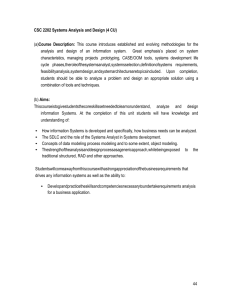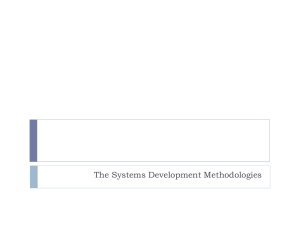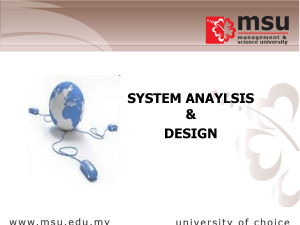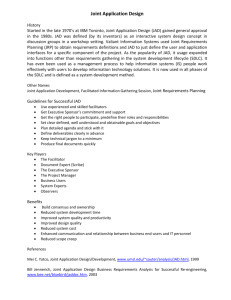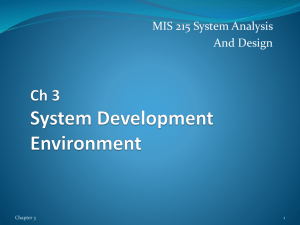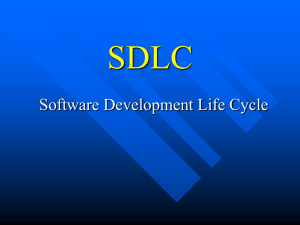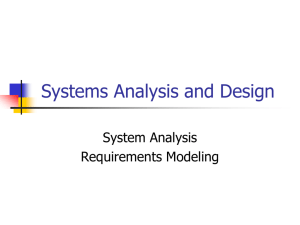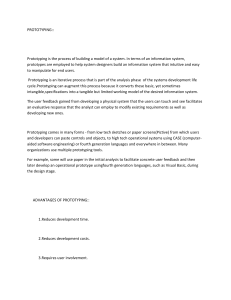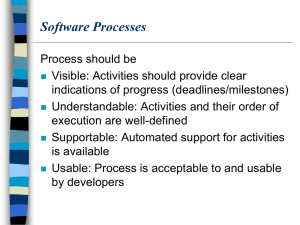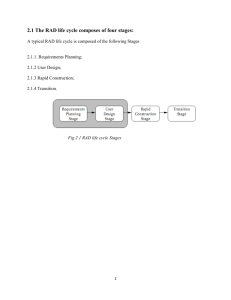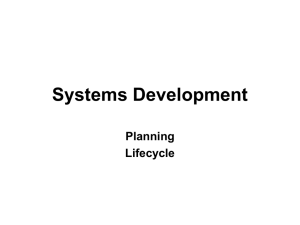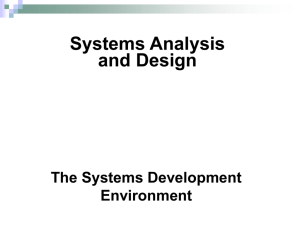Module 3 Notes
advertisement
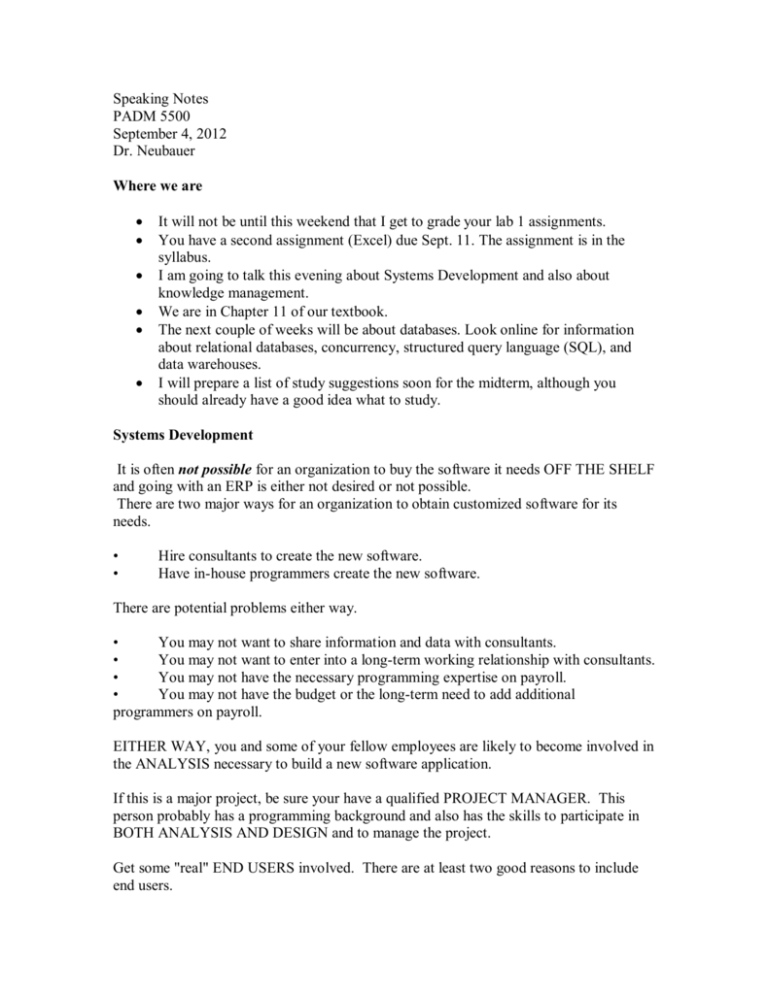
Speaking Notes PADM 5500 September 4, 2012 Dr. Neubauer Where we are · · · · · · It will not be until this weekend that I get to grade your lab 1 assignments. You have a second assignment (Excel) due Sept. 11. The assignment is in the syllabus. I am going to talk this evening about Systems Development and also about knowledge management. We are in Chapter 11 of our textbook. The next couple of weeks will be about databases. Look online for information about relational databases, concurrency, structured query language (SQL), and data warehouses. I will prepare a list of study suggestions soon for the midterm, although you should already have a good idea what to study. Systems Development It is often not possible for an organization to buy the software it needs OFF THE SHELF and going with an ERP is either not desired or not possible. There are two major ways for an organization to obtain customized software for its needs. • • Hire consultants to create the new software. Have in-house programmers create the new software. There are potential problems either way. You may not want to share information and data with consultants. • You may not want to enter into a long-term working relationship with consultants. • You may not have the necessary programming expertise on payroll. • You may not have the budget or the long-term need to add additional • programmers on payroll. EITHER WAY, you and some of your fellow employees are likely to become involved in the ANALYSIS necessary to build a new software application. If this is a major project, be sure your have a qualified PROJECT MANAGER. This person probably has a programming background and also has the skills to participate in BOTH ANALYSIS AND DESIGN and to manage the project. Get some "real" END USERS involved. There are at least two good reasons to include end users. Have a DEVELOPMENT METHODOLOGY for the entire SOFTWARE DEVELOPMENT LIFECYCLE (SDLC). There needs to be a SPONSOR -- someone who WANTS THIS TO HAPPEN and who has the money and/or clout in the organization to help make it happen. There should be a SYSTEMS ANALYST on board. This person UNDERSTANDS THE NEEDS OF THE ORGANIZATION (and its "business" processes) and has a clear understanding of HOW the new software is going to be used. SPECIFICATIONS ("specs") should be written, whether or not the (major) project is to be put out for bids. AVOID internal "power user" self development except possibly for a very simple, minor application. DON'T GET PULLED INTO BUILDING MORE STOVEPIPE APPLICATIONS! A USE CASE diagram is a very important tool during ANALYSIS. PROTOTYPING during JAD/RAD sessions can be very helpful in making sure everyone "is on the same page." But be sure everyone understands that the PROTYPE is not the real thing. It is a mock up of interface screens. The real work is done later in DESIGN and IMPLEMENTATION. A prototype is, "just a pretty interface." "SDLC" stands for, "software development lifecycle." It begins, well, at the beginning and, technically, continues so long as the application is being MAINTAINED. The most expensive part is maintenance. "Cutting corners" early on is not a good idea. THE PAIN ENDURES. Early mistakes/misunderstandings can be VERY, VERY COSTLY. A major project is likely to take 12 to 18 months or longer. The problem is, NEEDS CHANGE almost continuously. One approach is called the WATERFALL METHODOLOGY. The "spirit" of this approach is, "no going back." The major problem is that it is not agile enough and it delays testing until all the code is written, which is VERY RISKY. IDENTIFICATION OF A NEED ANALYSIS OF THE NEEDS DESIGN OF THE SOLUTION IMPLEMENTATION (WRITING CODE) TESTING DEPLOYMENT MAINTENANCE MAINTENANCE includes "bug fixes" and addition of features as it becomes necessary to add features. MAINTENANCE IS THE MOST COSTLY PART OF IT! There are two major problems associated with the actual use of this approach to the SDLC. 1) During a long project the needs of the organization are changing. It is not acceptable to be unable to accept CHANGE ORDERS until after deployment of the new system. 2) It is VERY RISKY to write all the source code before beginning to test it. 3) Also, you may have programmers sitting around doing nothing because they must wait until others do their part first. Representation of the Iterative-Incremental Methodology source: Rational Software Corporation (now part of IBM Corporation) This is the MORE MODERN and BETTER approach and is possible in large part because of the OBJECT-ORIENTED programming paradigm. PROGRESS is measured by the completion of PHASES which are broken down into multiple INTERATIONS. There is a MILESTONE at the completion of every PHRASE. At the end of every iteration you should REFACTOR all the artifacts of the project. Your development team can be doing multiple kinds of work at the same time. It is not necessary to finish one kind of work before going forward to the next. You can accommodate (reasonable) CHANGE REQUESTS while still in development. You start writing code and testing code quite early along the way. You can begin to deploy in BETA while still completing the programming and testing. On the examinations I will ask you to interpret what Core Process Workflows are being done in which project Phases. The spirit of the Iterative-Incremental approach is WE CAN DO MORE THAN ONE THING AT A TIME. At the end of every phase you REFACTOR everything to be sure you are ready to go forward. Refactoring is basically "getting your ducks in a row" so you can move forward to the next phase of the project. Things to notice about the iterative-incremental model of the SDLC: · Testing begins "early and often." As soon as there is code written it is being tested. It is the MODULAR nature of object-oriented programming that makes this possible. · Analysis and design are combined activities and continue well into the construction phase. · Deployment begins while code is still being written! This is sometimes called Beta testing. This may not be a good idea. Make sure you and the project manager understand each other in this regard. · This approach may look sloppy but it is not. It requires AN EXPERIENCED SOFTWARE PROJECT MANAGER. If you have such a person, treat him or her well. They are not easy to find and can make a lot more money in the private sector. Joint Application Development (JAD) http://en.wikipedia.org/wiki/Joint_application_design Rapid Application Development (RAD) http://en.wikipedia.org/wiki/Rapid_application_development Iterative Development http://en.wikipedia.org/wiki/Iterative_and_incremental_development Software Prototyping http://en.wikipedia.org/wiki/Software_prototyping The Iterative-incremental model of the SDLC described above is an example of iterative development. You may also hear reference to the spiral model, which is basically the same idea. JAD and RAD refer to getting all major stakeholders into the same room at the same time and using a computer and projector to model the new system and make sure everyone is "on the same page." Hopefully, this saves time and avoids misunderstandings. It is good to start with Use Case models and work on from there. Prototyping refers to projecting screens of the new system and designing the INTERFACE together in a JAD/RAD session. The important point is that THE PROTOTYPE IS NOT THE REAL THING. It is "just a pretty interface." All the real work has been stubbed out. It may look like the real thing. It may even appear to FUNCTION like the real thing. BUT IT IS NOT. The risk is that an inexperienced person may get the idea that "we are almost there." I think the prototype should be a THROW AWAY PROTOTYPE. In other words, all the REAL WORK comes later. The prototype is just for TALKING (AGREEMENT) PURPOSES. The code should not be considered application source code. A bit now about knowledge management. To me, this is what others often refer to as business intelligence. It is about getting KNOWLEDGE into the “right brain” at the right time. Let’s use an Arena model in class to talk about this.
